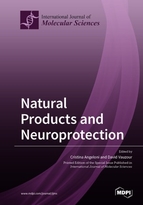Natural Products and Neuroprotection
A special issue of International Journal of Molecular Sciences (ISSN 1422-0067). This special issue belongs to the section "Bioactives and Nutraceuticals".
Deadline for manuscript submissions: closed (31 May 2019) | Viewed by 114725
Special Issue Editors
Interests: nutritional biochemistry; neurodegenerative diseases; oxidative stress; inflammation; nutraceuticals; ageing
Special Issues, Collections and Topics in MDPI journals
Interests: neurodegenerative disorders; phytochemicals; neuroinflammation; memory; learning and neuro-cognitive performances; signalling pathways; oxidative stress
Special Issues, Collections and Topics in MDPI journals
Special Issue Information
Dear Colleagues,
Neurodegenerative diseases are among the most serious health problems affecting millions of people worldwide, and their incidence is dramatically growing together with increased lifespan. These diseases are a heterogenous group of chronic, progressive disorders characterized by the gradual loss of neurons in the central nervous system, which leads to deficits in specific brain functions. The most common neurodegenerative diseases are Alzheimer's disease, Parkinson's disease, amyotrophic lateral sclerosis, multiple sclerosis, and Huntington's disease. These multifactorial debilitating disorders share common molecular and cellular characteristics, such as oxidative stress, mitochondrial dysfunction, protein misfolding, excitotoxicity, and inflammation. Nowadays, there are no therapeutic approaches to cure or even halt the progression of these disorders. In this context, natural products, because of their broad spectrum of pharmacological and biological activities, are considered promising alternatives for the treatment of neurodegeneration. Natural compounds have been recognized to possess different biological activities, including antioxidant, anti-inflammatory, and antiapoptotic effects. Moreover, natural compounds have been recently shown to counteract protein misfolding and to modulate autophagy and proteasome activity.
In this Special Issue, we invite investigators to contribute original research articles, as well as review articles regarding the biological effect of natural products in preventing/counteracting neurodegeneration.
Topics include, but are not limited to, the following:
- Clinical or preclinical studies investigating natural products in the treatment of neurodegenerative diseases
- The role of natural products in counteracting oxidative stress in neurodegeneration
- The role of natural products in counteracting inflammation in neurodegeneration
- The use of natural products in modulating autophagy and proteasome activity to counteract abnormal protein aggregation in neurodegeneration
- The role of natural products in modulating signaling pathways involved in neurodegeneration
- The use of natural products as lead compounds in drug discovery for the treatment of neurodegenerative diseases
Prof. Dr. Cristina Angeloni
Prof. Dr. David Vauzour
Guest Editors
Manuscript Submission Information
Manuscripts should be submitted online at www.mdpi.com by registering and logging in to this website. Once you are registered, click here to go to the submission form. Manuscripts can be submitted until the deadline. All submissions that pass pre-check are peer-reviewed. Accepted papers will be published continuously in the journal (as soon as accepted) and will be listed together on the special issue website. Research articles, review articles as well as short communications are invited. For planned papers, a title and short abstract (about 100 words) can be sent to the Editorial Office for announcement on this website.
Submitted manuscripts should not have been published previously, nor be under consideration for publication elsewhere (except conference proceedings papers). All manuscripts are thoroughly refereed through a single-blind peer-review process. A guide for authors and other relevant information for submission of manuscripts is available on the Instructions for Authors page. International Journal of Molecular Sciences is an international peer-reviewed open access semimonthly journal published by MDPI.
Please visit the Instructions for Authors page before submitting a manuscript. There is an Article Processing Charge (APC) for publication in this open access journal. For details about the APC please see here. Submitted papers should be well formatted and use good English. Authors may use MDPI's English editing service prior to publication or during author revisions.
Keywords
- oxidative stress
- inflammation
- protein misfolding
- natural compounds
- nutraceuticals
- phytochemicals
- neurodegeneration
- Alzheimer’s disease
- Parkinson’s disease
- amyotrophic lateral sclerosis
- multiple sclerosis
- Huntington's disease








